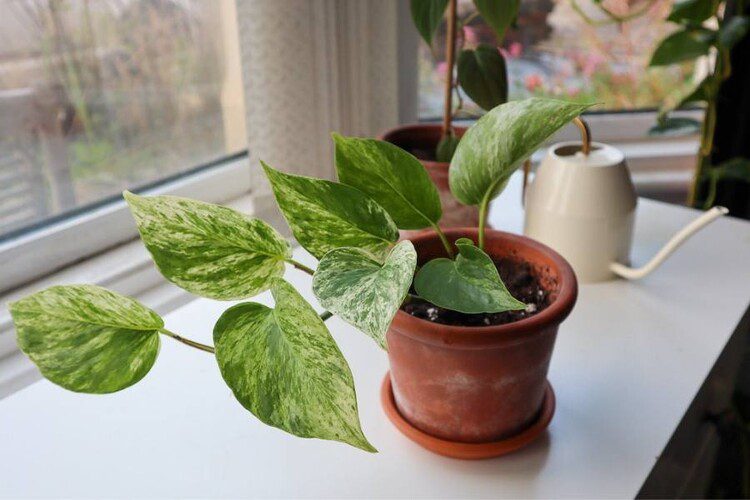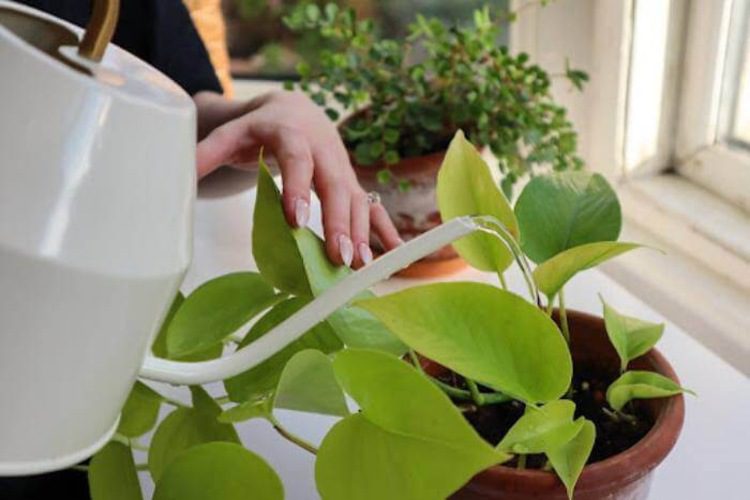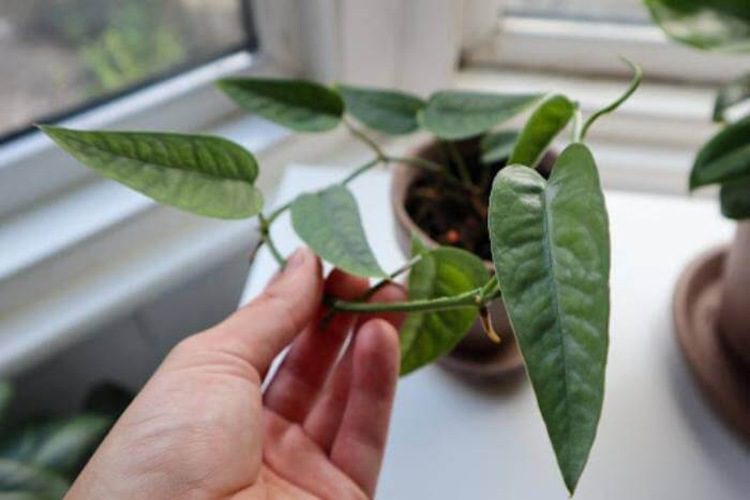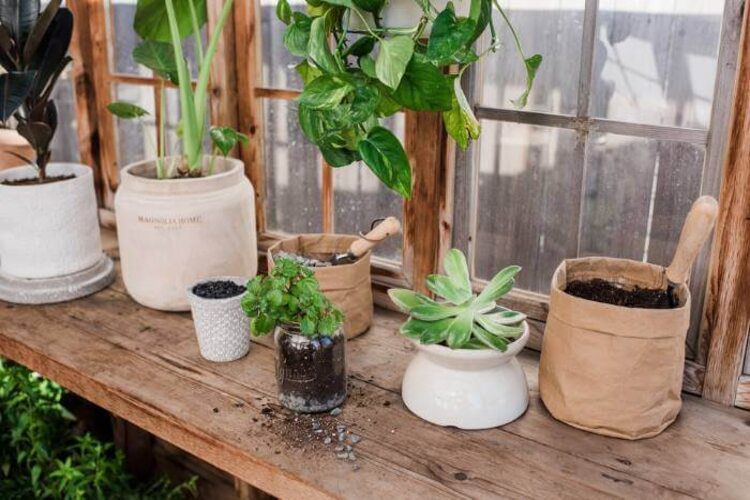How To Make Pothos Climb? 3 Effective Techniques

If you’re looking to spice up your workspace or apartment, Epipremnum aureum or Golden Pothos should do the trick. This robust green beauty gains a great reputation for being super effortless to maintain and ultimately foolproof for beginners. It’s no big secret that this heart-shaped green loves to vine.
This article will dig into the three most common methods to train these Pothos to climb and grow where you expect them to go.
How To Make Pothos Climb?
There are three effective techniques to train Pothos to climb onto your trellis: Balloon or hoop training, pole training, and indoor wall training.
Balloon or Hoop Training
The pothos plant works nicely twined around hoop trellises that encircle your pot. People also call these hoops balloon trellises. The trellises may come in various shapes, from U-shaped to semi-circular. All you need to do is insert a hoop trellis into the substrate.
Wind the longest stem around your hoop first to start training your greens. Then, attach it to the balloon hoop with gardening twine or wire. After that, wind the second-longest stem around that hoop. Keep doing so until you’ve attached all the stems to the balloon hoop.
If the green is too tiny to encircle the hoop entirely, wait for it to grow for a few months before winding it. It may be hard to repot your houseplant once the stem is entirely trained into a structure. This is most likely to happen to a robust wooden trellis.
Pole Training
If you’re a beginner pothos grower, we suggest using this straightforward training method. It gives trailing vines a focal support structure that can deter taller vines from leaning when growing. Pole training applies best to Golden Pothos, Ficus Elastica, Philodendron Creeping Fig, and Monstera. You must have seen many tropical houseplants developing around moss poles dug into the substrate.
The moss duplicates the vegetative, damp branches and trunks that pothos plants vine in rainforest habitats. Epipremnum aureum has aerial roots beneath the substrate, enabling it to surround a moss pole. Even when you didn’t force it, its aerial roots would grow anyway, waiting for a chance to climb.
The first step is to insert the moss pole into the soil’s center and use gardening twine or wire to tie the green stem to the pole. If your plants have supple stems, we recommend winding them around the poles when they grow loose and fixing them in place with twine or wire.
After that, leave the rest to your plants. If your greens are powerful, vigorous growers, ensure the poles stand much taller than them. But if the plants are already mature, removing them from the pots is necessary before digging the stake. After the removal, dig the pole into the pot’s center. Re-pot your green to make it stand snugly beside the stake, then replace the substrate.
Tying the stems at some points to the stake with gardening twine or wine is an essential step to stimulate your plants to stick to the stake.
Indoor Wall Training
If you attempt to train your Epipremnum aureum to latch onto a wall, the crucial step is to provide it with a sustainable support system. It’s advisable to use this method when the plant is still immature or wait for the stems to thicken. The tools you’ll need for wall training are a solid framework, twine or wire, nails, and hooks.
First, tie the stems around the robust framework, then attach the anchoring system you’ve chosen to the houseplant. After that, simply observe its growth. Next, choose your favorite patterns for the wall. Feel free to put your creativity into practise.
After locating a perfect corner, position the hooks or nails in connection with the rope’s length. We suggest starting with the most extended one and moving down gradually. Then, tie the stems around a thread. You’ll need many threads since the greens will keep thriving. The last step is to train the stems around the string the way you want.
Moreover, you should train your Epipremnum aureum to latch onto a wall and separate pets from the Pothos plant. Pothos are toxic to pets, causing vomiting and diarrhoea. Keep the plant out of reach and place it in a hanging basket or pot with a tall stand.
What Materials That Stimulate Pothos?
When it comes to how to train pothos to climb, people usually use these four materials to help with the process:
- Moss pole
The most highly recommended way to encourage trailing pothos vines to climb in the correct direction is to use moss poles. These kits act as anchors to which your pothos plant will cling. Besides, the moss pole can help mimic the natural habitat of Epipremnum aureum and provide it with water, but it does not provide micronutrients via aerial roots.
- Trellis
Another material commonly used for stimulating pothos to latch on is a trellis. It’s the ingredient you need when your greens start sagging in the summertime. Trellis can also act as a sturdy support system for the pothos plants during the winter, if necessary. It helps your trailing vines head upward.
- Metal pole
People use metal poles to support climbing pothos plants and make them stay vertical. These long steel pipes are well-known for being extremely long-lasting and are claimed to remain good for up to 50 years, but this can vary depending on the specific pole and its maintenance. However, it’s essential to be cautious when adding any chemical to the water since it can ruin your metal poles.
- Bamboo pole
A significant advantage of bamboo is that it’s pest-resistant. Like metal poles, bamboo ones can support and keep your Epipremnum aureum vertical, but please note that they may pierce your green roots from the soil if not inserted carefully. While moss poles can stay moist for an extended period, bamboo poles can’t. Thus, it’s best to water your pothos plants more often.
When Should You Start Training Your Pothos to Climb?
It’ll take about 1–2 years to make your houseplants climb if you soak them in water, but this time frame depends on the specific plant and its growing conditions. People select long-haired plants to make it easier to train pothos to climb. Also, the Epipremnum aureum should grow appropriately before diving into the training so it can wind around an anchoring system sustainably.
Observe its growth frequently to see if the stems are sturdy enough to carry more giant, heavyweight leaves. If so, now is the time to start training your plants.
Does Pothos Prefer Hanging Or Climbing?
This climbing vine loves both hanging and climbing and will look stunning either way in your house. With proper care, it will thrive in any condition. If it climbs, the leaves may be quite lush and large. The vine naturally winds itself around stakes and trees to go up.
Also, it can hang well, particularly when frequently motivated through pruning. Ensure the pots have drainage holes to make your greens hang or climb properly. The plants shouldn’t sit in humidity for an extended period since it might result in root rot, infestation issues, or mold.
Does Pothos Damage Your Walls?
While climbing vines bring a pleasing aesthetic to your home, some varieties may ruin your walls. Notably, those with small spikes and branches may scrape the wall’s paint and go through the wall.
Does this happen with Epipremnum aureum? Fortunately, that’s not the case. This variety is an environment-friendly presence in your house. Though it has aerial roots, those will barely hurt your walls. However, in some cases, they can provide adequate support for the Epipremnum aureum to peel the wall. If you notice signs of that happening, don’t hesitate to prune them.
How Long Does It Take Your Pothos To Climb?
Is training a pothos plant to climb a long process? If the plant is immature when you bring it home, it will take 1-2 years to mature and become durable enough to begin training. You need to wait until then to start the process.
If you bought it as a mature green, you could proceed with the training immediately. It will take several weeks for large plants to begin climbing. The specific time you expect to spend on the training process depends on how much water and light you provide to the greenery and how large the pots are.
Tips For Pushing Your Pothos To Climb Faster
The key tips for stimulating pothos to vine faster are to provide an adequate amount of sunlight, fertilize it every 3-4 months, and maintain a temperature of 70–90 degrees F. This variety is a fast grower compared to other trailing vines, so caring for them thoroughly will bring you fruitful results in the end.
The most crucial thing is to avoid overfeeding and overwatering the plant, since this may lead to root rot. It occurs when the greenery starts decaying because of prolonged exposure to too much moisture.
Conclusion
Depending on your goals, you can choose either of the three settings above to train your houseplants to wind around your rafters or cover a vertically lush garden wall. With a sustainable support system (walls, hoops, poles, canes, etc.) and adequate lighting, your greenery will become a powerful climber.
Following the tips above, you’ll see your pothos climbing and thriving soon!
Related post:









